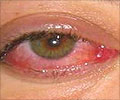Contact lenses may sometimes identify the organisms involved in cases of corneal eye infection.
According to a report in the September issue of Archives of Ophthalmology, one of the JAMA/Archives journals, cultures of contact lenses may sometimes identify the organisms involved in cases of corneal eye infection.
“Contact lens wear is associated with a significant risk of microbial keratitis [corneal eye infection] leading to severe sight-threatening complications,” the authors write. “Microbial keratitis has been seen in all types of lenses, including rigid gas-permeable lenses, hard or poly-methylmethacrylate lenses and high-and-low-oxygen transmissibility soft lenses, as well as with all modes of wear, including daily wear, extended wear, therapeutic wear and continuous wear.” Patients using soft contact lenses are more likely to develop the infection than those using other lenses.Sujata Das, M.S., F.R.C.S., of the Center for Eye Research Australia, University of Melbourne and Royal Victorian Eye and Ear Hospital, Melbourne, Australia, and colleagues reviewed the records of 49 patients (average age 34) with contact lens-related microbial keratitis between January 2001 and December 2004 to study the association between cultures of contact lenses and cultures of corneal scrapings. Age, sex, symptoms, results and predisposing factors were reported.
Among the 49 patients, there were 50 eyes with microbial keratitis. Seventeen corneal scrapings (34 percent) and 35 contact lenses (70 percent) were found to have organisms growing on them. In 13 eyes, identical organisms were growing in the cultures taken from the corneal scrapings and from the contact lenses. Different organisms were found in the corneal eye scrapings and the contact lenses in two eyes. Only corneal scrapings were found to be culture positive in two eyes.
Serratia marcescens was the most common organism found in both the corneal scrapings and the contact lenses.
“Our study highlights the fact that contact lens culture may help in identification of the causative organism in many cases of contact lens-related microbial keratitis,” the authors conclude.
“Also, contact lens culture may give a clue regarding the identity of the causative organism in situations in which the corneal scraping is culture negative and may help in choosing the appropriate antimicrobial agent.” However, the cultures found on contact lenses cannot replace those found in corneal scrapings.
Advertisement
LIN /J









